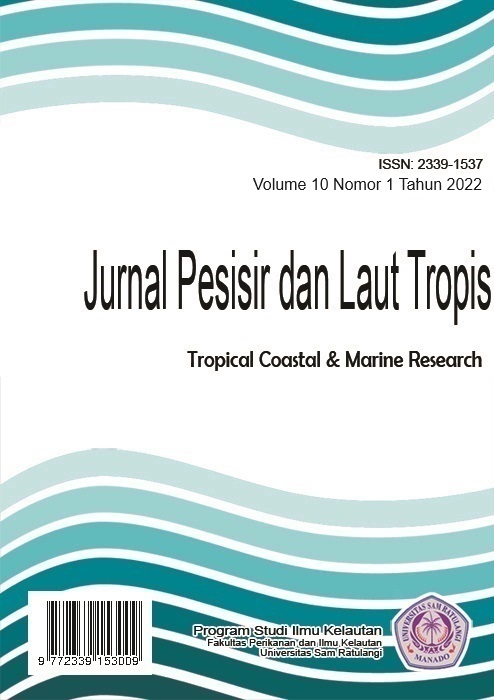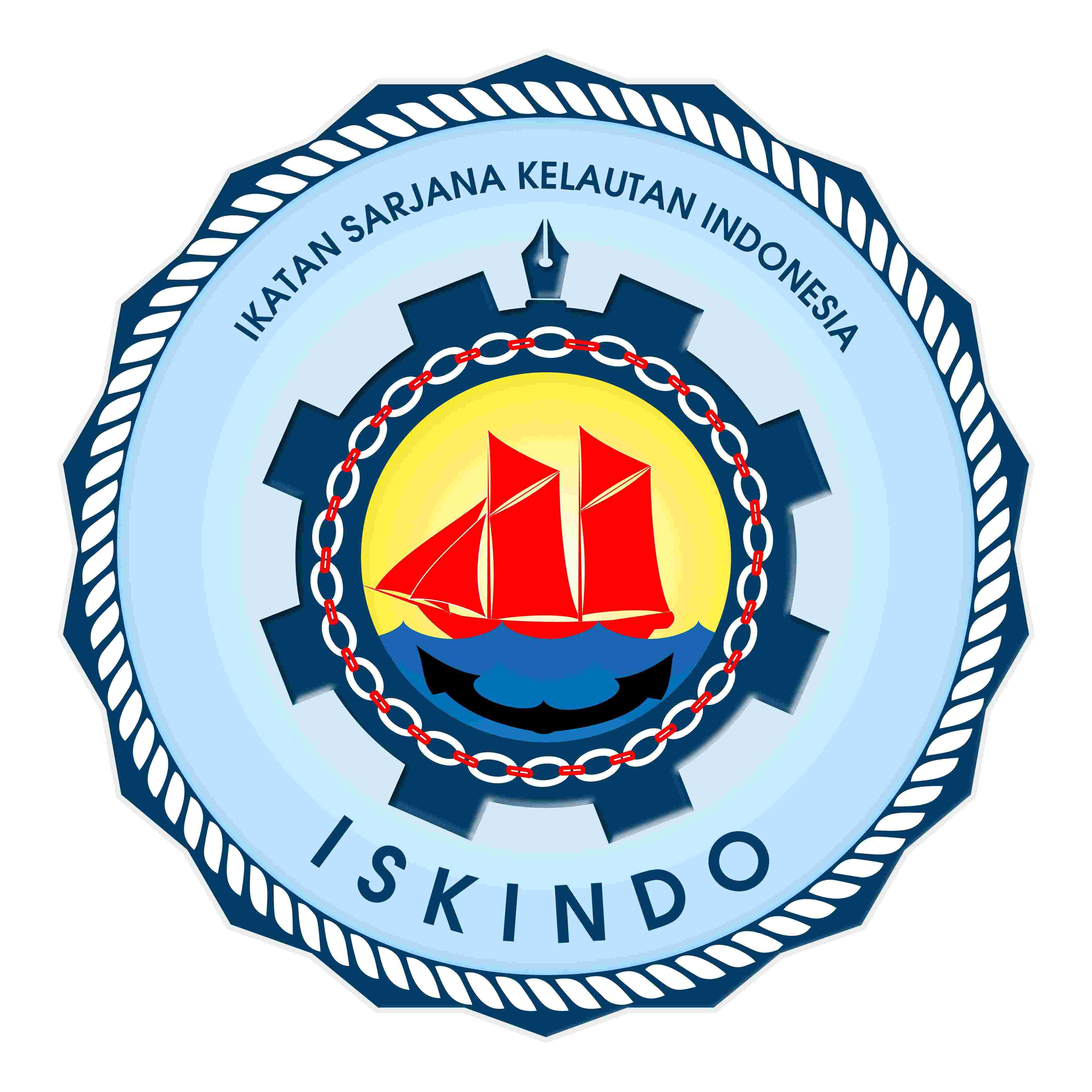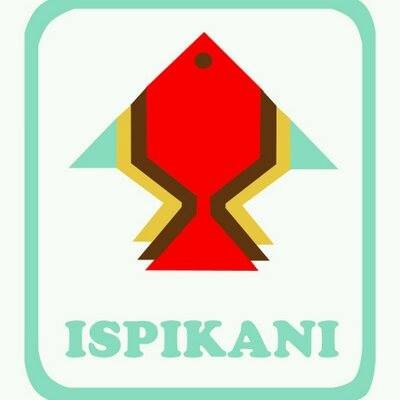IDENTIFIKASI SAMPAH ANORGANIK PADA EKOSISTEM MANGROVE PANTAI TASIK RIA KECAMATAN TOMBARIRI KABUPATEN MINAHASA
DOI:
https://doi.org/10.35800/jplt.10.1.2022.54944Keywords:
Pesisir, Ekosistem Mangrove, Identifikasi, Marine Debris, Pantai Tasik RiaAbstract
Threats to the marine and coastal environment are increasing due to the increasing population and increasing exploitation of the population on the coast. If the garbage is thrown into the river or thrown directly into the sea, it will eventually result in a reduction in the beauty of the coastal area, the sea and the mangrove ecosystem. Inorganic waste with the type of plastic will not be separated from everyday life, due to the increasing number of people in the world. Therefore, the demand for and consumption of plastic-type materials is increasing and will continuously enter the land environment to the sea. Sampling is located at Tasik Ria Beach, Tombariri District, Minahasa Regency. The sampling time for marine debris in the mangrove ecosystem will be in August 2021. Inorganic waste sampling is carried out in the mangrove ecosystem by looking at the age of the month at the lowest low tide. Sampling used the line transect method or quadrant line transect and was carried out directly in the morning and it took one day until the tide started. Based on the research objectives, to identify inorganic marine debris found in the mangrove ecosystem of the Tasik Ria beach and analyze the total density of inorganic marine debris, both heavy and the amount laid on the mangrove ecosystem, research conducted at Tasik Ria Beach, Tombariri District, Minahasa Regency has obtained five types of waste. namely plastic, glass, metal, rubber and wood waste and their derivatives.
Keywords: Coastal, Mangrove Ecosystem, Identification, Marine Debris, Tasik Ria Coast
ABSTRAK
Ancaman terhadap lingkungan laut dan pesisir semakin meningkat diakibatkan oleh bertambahnya jumlah penduduk dan bertambah pula eksploitasi penduduk di pesisir. Apabilah sampah tersebut dibuang ke sungai maupun dibuang langsung ke laut yang akhirnya berakibat berkurangnya keindahan wilayah pesisir, laut maupun pada ekosistem mangrove. Sampah anorganik dengan jenis plastik tidak akan terlepas dengan kehidupan sehari-hari, dikarenakan bertambahnya jumlah penduduk di dunia. Maka dari itu permintaan maupun kunsumsi bahan dengan berjenis plastik semakin meningkat dan akan secara terus-menerus masuk ke lingkungan daratan sampai ke laut. Pengambilan sampel terletak di Pantai Tasik Ria Kecamatan Tombariri Kabupaten Minahasa. Waktu pengambilan sampel sampah laut pada ekosistem mangrove dilaksanakan pada bulan Agustus 2021. Pengambilan sampel sampah anorganik di lakukan pada ekosistem mangrove dengan melihat umur bulan pada saat kondisi surut terendah. Pengambilan sampel menggunakan metode line transek atau transek garis kuadran dan dilakukan secara langsung di pagi hari dengan membutuhkan waktu selama satu hari sampai pada saat air mulai pasang. Berdasarkan tujuan penelitian mengidentifikasi sampah laut anorganik yang terdapat di ekosistem mangrove pantai tasik ria dan menganalisa jumlah kepadatan sampah laut anorganik baik itu berat maupun jumlah yang tergampar pada ekosistem mangrove penelitian yang di lakukan di Pantai Tasik Ria Kecamatan Tombariri Kabupaten Minahasa telah di dapatkan lima jenis sampah yaitu sampah jenis plastik, kaca, logam, karet serta kayu dan turunannya.
Kata Kunci : Pesisir, Ekosistem Mangrove, Identifikasi, Marine Debris, Pantai Tasik Ria
References
Renwarin, A., Rogi, O.A.H., Sela, R.E. 2002. Studi Identifikasi Sistem Pengelolaan Sampah Permukiman Di Wilayah Pesisir Kota Manado. Jurnal. Program Studi Perencanaan Wilayah dan Kota, Universitas Sam Ratulangi. Manado. Berkas Penelitian Hayati, 18, 83-85.
NOAA (National Oceanic and Atmospheric Administration). 2013.
Programmatic Environmental Assessment (PEA) for the NOAA Marine Debris Program (MDP). NOAA. Maryland (US).
Walalangi, J. Y. 2012. Analisis Sampah Organik Serta Dampak Terhadap Lingkungan Pesisir Kota Palu Sulawesi Tenga. Tesis Institute Pertanian Bogor.
NOAA. 2015. Turning the Tide on Trash. A Learning Guide On Marine Debris. NOAA PIFSC CRED.
Djaguna, A., Pelle, W. E., Schaduw, J. N. W., Manengkey, H.W.K., Rumampuk, N. D. C., Ngangi, E. L. A. 2019.
Identifikasi Sampah Laut di pantai tongkaina dan talawaan bajo. Jurnal Pesisir dan Laut Tropis, Fakultas Perikanan dan Ilmu Kelautan. Universitas Sam Ratulangi.
Downloads
Published
How to Cite
Issue
Section
License

This work is licensed under a Creative Commons Attribution-NonCommercial 4.0 International License.
















